E-cig packaging: Where there’s (no) smoke, there’s fire
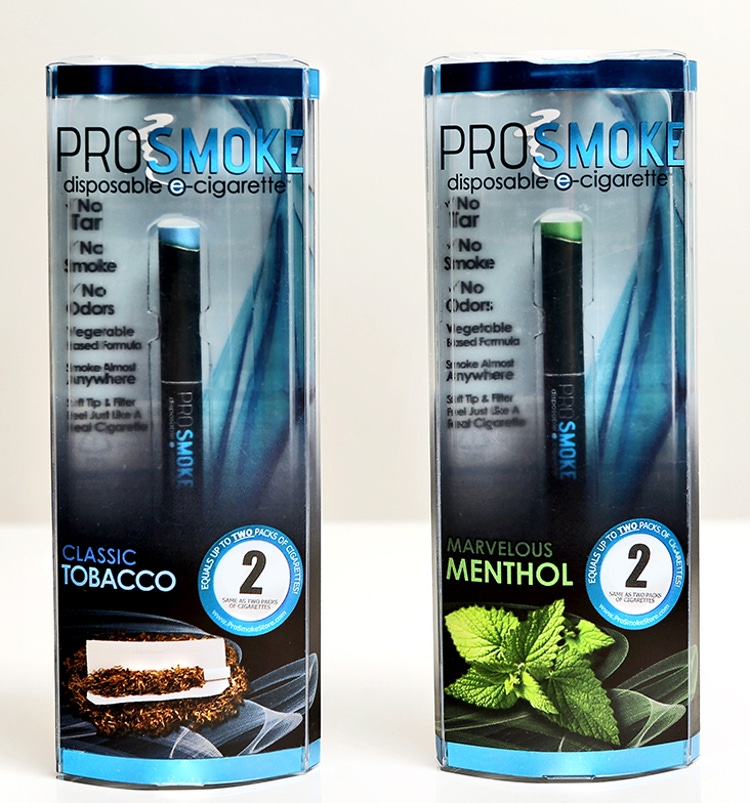
Brand owners appeal to vapers with packaging that educates, elevates and differentiates.
E-cigarettes, like the tobacco products that preceded them, have their share of critics. But no one can deny the packaging opportunity currently bubbling up in the e-cig market. With mass-market retail joining the internet as a key e-cig sales channel, demand for package designs that draw the eye and convey brand value is strong and getting stronger.
That trend promises to continue in tandem with e-cig market growth. BIS Research recently predicted that the global e-cig industry will experience compound annual growth of more than 22% between 2015 and 2025, and that e-cigs will reach a market value of $50 billion by 2025.
Various factors are driving the boom, with user age playing a role. For late teens, vaping is a trendy social habit; the desire to emulate their peers is encouraging Millennials to use e-cigs and other vaping devices.
Among older consumers, some who previously smoked have turned to vaping as a way to get away from tobacco—with its health risks and social stigmatization—while still getting a nicotine fix. For this group, e-cigs that simulate conventional cigarettes (with, for example, an LED on the end that lights up when they inhale) can be attractive.
In addition, smokers sometimes turn to e-cigs as a smoking-cessation aid that provides smoking’s sensory cues, either with or without nicotine.
So what exactly is an e-cigarette? “E-cig products are battery-powered personal vaporizers that mimic the sensation of smoking,” says Patrick Meredith, divisional innovations director at Essentra, a company that manufactures e-cigs and designs packaging for them.
He adds that there are various types of products in the category, including single-use disposables, multiuse rechargeable vaping devices and larger tank-based systems. In all cases, a heating element inside the device heats and atomizes a solution called e-liquid, which is contained in a reservoir. The consumer inhales the vapor from the device’s mouthpiece.
E-liquids come in various nicotine strengths, or with no nicotine at all, and they’re available in myriad flavors. Many have a sweet and/or fruity flavor profile, like mango, butterscotch, chocolate, banana or doughnuts.
Some vaporizers, including rechargeable e-cigs, use prefilled, sealed, disposable containers of e-liquid. Others need to be manually refilled with e-liquid, which is typically sold in small bottles.
Child safety
Although e-cigs and other vaping devices don’t create smoke, opinions about their use are divided. Some view them as positive, society-friendly products that reduce tobacco-related social friction and illness—or as a tool for smokers wishing to quit that habit. Others see vaping as a gateway to tobacco smoking, specifically for teens and young adults.
But all agree on the need to keep nicotine-containing e-liquids away from children, who can be sickened or even killed by ingesting it. To that end, President Obama in January 2016 signed the Child Nicotine Poisoning Prevention Act of 2015 into law. This legislation requires liquid nicotine to be packaged in accordance with the Poison Prevention Packaging Standards (16 C.F.R. 1700.15).
The new federal child-resistant packaging legislation does not apply to pre-filled, sealed, disposable e-liquid containers, but rather to the small containers of e-liquid used with refillable devices. The law will take effect this summer.
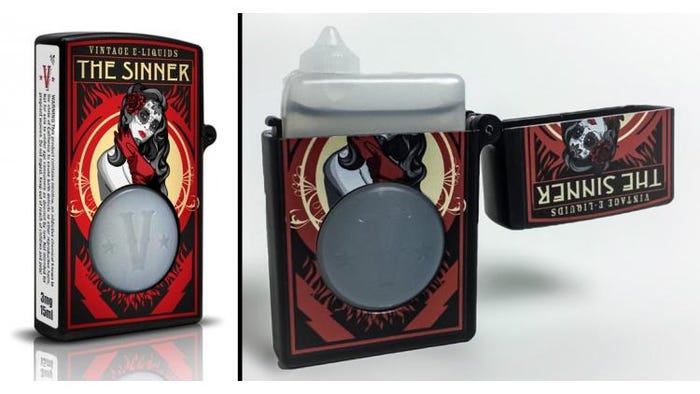
Vintage E-Liquids’ One Flick dispenser (above), for example, was recently redesigned to be child resistant. These distinctive e-liquid dispensers combine innovative structural design with arresting graphics to position the products as lifestyle accessories. Read more about the Vintage packaging here.
“Although our disposable e-cig packaging is exempt from this legislation, since [the product] is pre-filled with e-liquid, ProSmoke uses [a] blister clamshell with child-resistance in mind,” says Matthew Nocifora, president of ProSmoke. A single electronic cigarette, the equivalent of two-plus packs of tobacco cigarettes, is contained in each of the blister clamshells.
“The ProSmoke Disposable packaging was designed from the ground up, in-house. It is a two-part system consisting of a blister clamshell and semi-transparent outer sleeve,” Nocifora says. “The child-resistant clamshell has holographic security/freshness seals on both the top and bottom of the internal clamshell. The sealed internal clamshell is then covered by the outer plastic sleeve.” (see photo at top)
In addition, ProSmoke’s packaging carries warnings that the products are “only allowed for sale to those of legal smoking age,” Nocifora adds. “ProSmoke was one of the original companies in the U.S. market and has always been a proponent of safe packaging and sensible legislation like purchase-age requirements.”
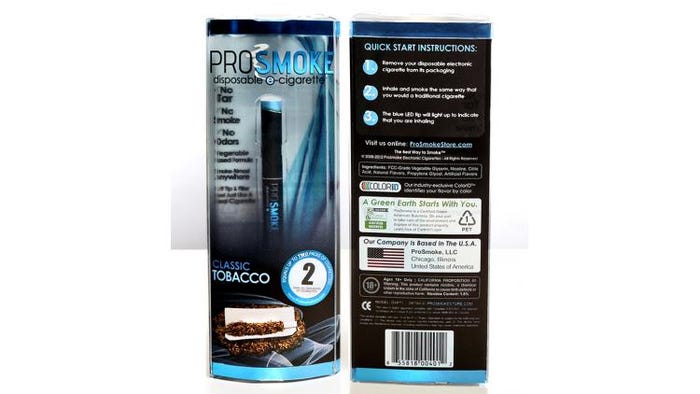
ProSmoke's back panel helps educate consumers on which e-cig products are right for them.
A clear view
Packaging for ProSmoke’s disposable e-cigs includes a recessed peg-hole tab, making it suitable for vertical on-shelf stocking or peg merchandising. The package is decorated with vivid graphics and metallic-foil accents.
“The packaging’s exterior is partially transparent and gives a full view of the product inside. Since the electronic-cigarette market is still maturing, many customers are still educating themselves on what products are, and which brand they should choose,” Nocifora explains.
“For this reason, the exterior of the packaging was specifically designed to not only be attractive and eye-catching on the shelf, but to also be as informative as possible,” he adds. “The transparent front also works as a window to view more product details on the inside.”
Indeed, windows, blister cards and other forms of transparent packaging are quite popular among e-cig brand owners. “Many of the leading e-cigarette marketers are using some type of visual or high-visibility packaging,” says Patrick McGee, vp of marketing at HLP Klearfold.
“In this developing market, e-cig producers see the value in allowing potential consumers to have a direct view of their products within the package, and we’ve seen a significant interest from e-cig producers in the use of high-quality plastic folding cartons, like our Klearfold clear packaging,” McGee says.
Depending on the brand, clear cartons may be appropriate for products ranging from vaporizers to vaping starter kits to replacement e-liquid cartridges.
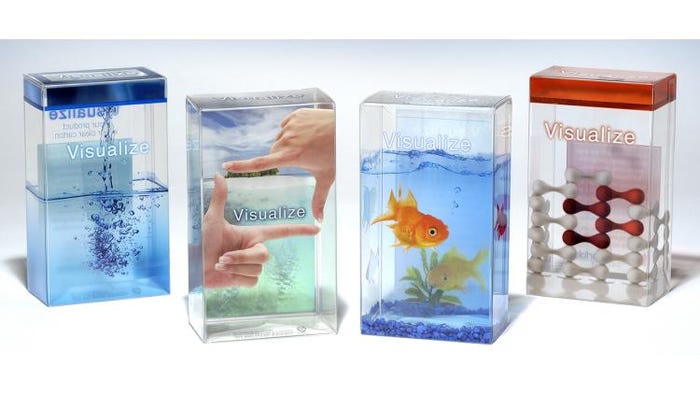
Transparent packaging like HLP Klearfold’s plastic carton let consumers see the e-cig product or kit in the package before buying, which new e-cig users particularly appreciate.
Package graphics help shoppers
For mid-market products purchased by experienced e-cig users, transparent packaging plays a less prominent role.
Fontem Ventures (a subsidiary of Imperial Brands PLC), for example, uses paperboard cartons to package its blu PLUS+ Tanks. Like blu e-liquid cartridges, the prefilled, sealed flavor tanks are designed to screw onto a rechargeable blu e-cig battery. The tanks are larger, however, holding about twice as much e-liquid as the cartridges.
The tank cartons are decorated with contemporary, upscale graphics that make it easy to shop the product family, whether the consumer is in a brick-and-mortar store or shopping online. The graphics feature a flavor icon—a signature image, like a sprig of mint or a vanilla flower—plus color coding to help shoppers quickly locate their preferred e-liquid flavor.
“The packaging design carries a triangular pattern that replicates the glow of the blu logo. We also have included flavor icons to give the consumer a visual attachment to the flavor,” says John Wardley, chief marketing officer at Fontem Ventures. The package graphics were designed in-house by the blu Creative Team.
The blu PLUS+ Tanks come in seven flavors: Classic Tobacco, Magnificent Menthol, Cherry Crush, Vivid Vanilla, Carolina Bold, Peach Schnapps and Piña Colada. The first four are sold at retail, and all seven are sold online. Each carton holds three flavor tanks, which are packed in a multi-compartment polypropylene tray sealed with lidding film.
The carton substrate is a matte-finish BOPP/paper laminate, and the package’s four-color printing is accented with spot UV varnish on the flavor icons. The combination of matte and gloss works on multiple levels, creating a package that’s visually striking as well as pleasing to hold and touch. The graphics and surface treatment also jointly convey the brand’s premium positioning.
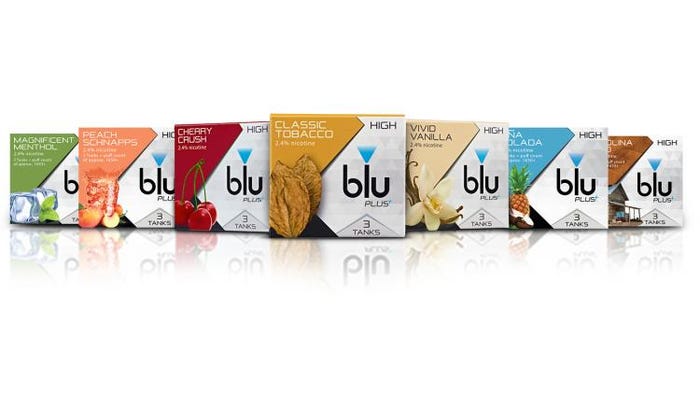
Cartons for blu PLUS+ Tanks use flavor icons to help consumers find their preferred flavor, and the package’s matte texture is fingertip-friendly.
Packaging with impact
“I see lots of impressive designs for vaping product packaging. The industry is using all of my favorite packaging elements from the high-end consumer packaging segment today—from finishes like soft-touch to specialist varnishes—to make packaging look glossy,” says Essentra’s Meredith.
“We are also seeing lots of tactile effects, including embossing and de-bossing, that engage the consumer with a multisensory experience,” he adds. “Packaging designs are modern, and they are incorporating trendy elements in other sectors, from patterns to relevant colors, [to] reflect the brands they represent.”
Meredith notes that a less restrictive packaging environment for vaping products, versus tobacco, lets e-cig manufacturers “leverage packaging to make a statement about their brand and use packaging to express points of potential product differentiation.”
As an example, “A combination of embossing and high-gloss varnish creates visual and tactile effects that create a feeling of indulgence,” he says. “These effects can be used throughout the packaging elements, from cartons to labels, to maintain the consistency of the brand and image portrayed.”
For brand owners with products like bourbon or perfume, this is a time-proven brand/packaging strategy. McGee of HLP Klearfold says “well-designed, beautifully decorated” versions of his company’s namesake plastic carton have been used for premium positioning and to elicit a value-added perception in the cosmetics, personal care, consumer electronics, sporting goods and spirits markets. “We see the packaging and merchandizing needs of e-cigarettes as similar.”
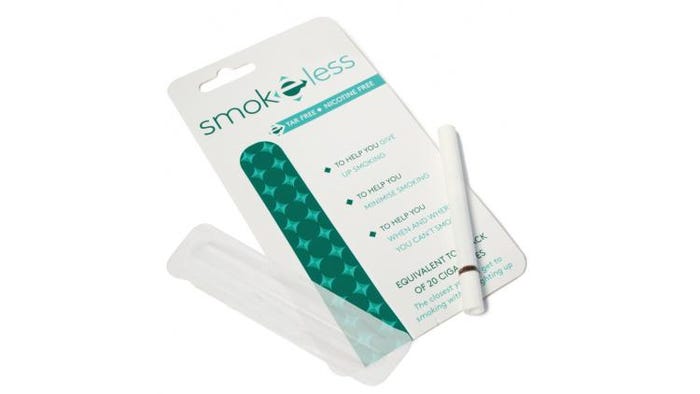
Carded blister packs put the e-cig product on display while providing space for branding and product messages. Photo courtesy of Essentra.
Kate Bertrand Connolly is a seasoned freelance writer based in the San Francisco area covering the packaging, food and technology markets. You can contact her at [email protected].
**************************************************************************************
See a host of new ideas in packaging machinery, materials and more at EastPack 2016, June 14-16, in New York City.
About the Author(s)
You May Also Like




